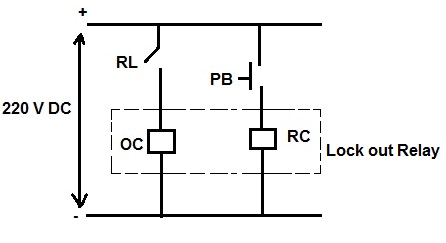What is a Lock Out Relay?
Lock out relay is an electromechanical relay which latches its output contact. As the name suggests, this relay once operated locks out the circuit. Locking out means that circuit cannot be normalized until and unless this relay is reset. These relay have two types of coils: operating and resetting coil. Operating coil when energizes, operates the relay. Resetting coil is energized to reset. This relay is not self resettable, it requires manual resetting for normalizing the protection and trip circuit.
The output contacts of lock out relay are wired to the breaker trip coil circuit. Therefore, whenever the relay gets energized, trip command to the breaker is issued. This relay is also known as Master Trip Relay and its ANSI code is 86. It is provided with flag. The relay gets flagged on actuation.
Principle of Lock Out Relay:
We know that relay is a protection device which senses an abnormal condition or fault in the system and issues tripping command to the circuit breaker to isolate the faulty part from the system. The decision for fault condition in the system is taken by the relay based on its setting. If the system parameter exceeds the setting value, relay assumes it as an abnormal / fault condition.
Suppose the current setting for an instantaneous overcurrent relay is 200% of the nominal value. If the relay senses that the circuit current is more than this setting then it will declare it as a faulty condition and will change its output contact RL from NO to NC. Thus the 220 V DC supply to the operating coil OC of master trip relay will be extended and hence it will be energized. Figure below shows the simple diagram to show the working principle of master trip relay.

On energization of lock out relay, its output contacts will change their status. If Normally Open (NO) contacts of this relay are used in trip circuit, then, this contact will become NC and hence the 220 V DC supply to the trip circuit will be extended. This in turn will trip the circuit breaker.
A push button PB is provided for relay resetting. Pressing the push button PB, extends the 220 V DC to the resetting coil RC and thus relay gets reset.
Any protection relay can be made to latch its output contact to provide lock out function. But it is also possible to use a single lock out relay (86). In this scheme, output contacts of different protection relays are parallel connected to the operating coil OC of the master trip relay. Thus if any one of the protection relay actuates, master trip relay will be operated and flagged. The operator then needs to identify the fault, rectify it and then reset the lock out relay to normalize the system by closing the circuit breaker
Very useful materials..
Thank you! Please share as it will help me.
Thx so much